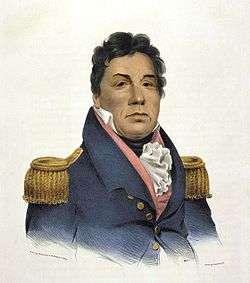Treaty of Doak's Stand
The Treaty of Doak's Stand (7 Stat. 210, also known as Treaty with the Choctaw) was signed on October 18, 1820 (proclaimed on January 8, 1821) between the United States and the Choctaw Indian tribe. Based on the terms of the accord, the Choctaw agreed to give up approximately one-half of their remaining Choctaw homeland. In October 1820, Andrew Jackson and Thomas Hinds were sent as commissioners who represented the United States to negotiate a treaty to surrender a large portion of Choctaw country in Mississippi. They met with tribal representatives at Doak's Stand on the Natchez Trace. They met with the chiefs Pushmataha, Mushulatubbee, and Apuckshunubbee, who represented the three major regional divisions of the Choctaw. Chiefs of the towns and other prominent men accompanied them, such as Colonel Silas Dinsmoor.

Dinsmore was a former US Indian agent to the Choctaw; his passport ruling in 1812 had stirred a brief controversy with General Andrew Jackson. Dinsmore was at the negotiations to settle a land claim; he believed the policy of the American government toward the Indian tribes was too harsh. His attitude suggested a potential confrontation, but Jackson paid no attention to him.[1]
The convention began on October 10 with a talk by Jackson (whom the Choctaw nicknamed Sharp Knife), to more than 500 Choctaw. After Jackson presented his proposal to exchange Choctaw land for territory in present-day Arkansas, Pushmataha accused the general of deceiving them about the quality of land west of the Mississippi. Pushmataha said, "I know the country well ... The grass is everywhere very short ... There are but few beavers, and the honey and fruit are rare things." Jackson finally resorted to threats to pressure the Choctaw to sign a treaty. He shouted, "Many of your nation are already beyond the Mississippi, and others are every year removing .... If you refuse ... the nation will be destroyed." On October 18, 1820, the chiefs signed the treaty.[1]
Article IV prepared the Choctaw to become citizens of the United States when he or she became acculturated. This article would later influence Article XIV in the 1830 Treaty of Dancing Rabbit Creek.
ART. IV. The boundaries hereby established between the Choctaw Indians and the United States, on this side of the Mississippi river, shall remain without alteration until the period at which said nation shall become so civilized and enlightened as to be made citizens of the United States, and Congress shall lay of a limited parcel of land for the benefit of each family or individual in the nation. ...
— Treaty of Doak's Stand, 1820
Terms

The preamble begins,
WHEREAS it is an important object with the President of the United States, to promote the civilization of the Choctaw Indians, by the establishment of schools amongst them; and to perpetuate them as a nation, by exchanging, for a small part of their land here, a country beyond the Mississippi River, where all, who live by hunting and will not work, may be collected and settled together. And whereas it is desirable to the state of Mississippi, to obtain a small part of the land belonging to said nation; for the mutual accommodation of the parties, and for securing the happiness and protection of the whole Choctaw nation, as well as preserving that harmony and friendship which so happily subsists between them and the United States, James Monroe, President of the United States of America, by Andrew Jackson, of the State of Tennessee, Major General in the Army of the United States, and General Thomas Hinds, of the State of Mississippi, Commissioners Plenipotentiary of the United States, on the one part, and the Mingoes, Head Men, and Warriors, of the Choctaw nation, in full Council assembled, on the other part,: have freely and voluntarily entered into the following articles, viz ...
— Treaty of Doak's Stand, 1820
The terms of the treaty were:
1. Choctaw land (in Mississippi) ceded to the U.S.
2. Boundary of western land (in Arkansas) ceded to the Choctaw nation.
3. Marking of boundaries by Choctaw-appointed guide.
4. Boundaries may not change until the Choctaw are civilized and enlightened so as to become citizens of the United States.
5. Corn, Blankets, kettles, rifle guns, bullet moulds & nippers, and ammunition to be given to Choctaws, who moved from ceded territory to lands west of the Mississippi River (Oklahoma), for one year.
6. U.S. agent appointed, goods and supplies to be sent, and a blacksmith will be appointed to Choctaws in ceded lands. Property of removed Choctaws to be sent to them.
7. Selling of Choctaw lands to support Choctaw schools on both sides of the Mississippi River.
8. Annuity of $6000 US annually for 16 years for discontented Choctaws.

Signatories
Andrew Jackson, Thomas Hinds, Apukshunnubbee, Pooshawattaha, and Mushulatubbee.
See also
Citations
- Remini, Robert. "Expansion and Removal". Andrew Jackson. History Book Club.